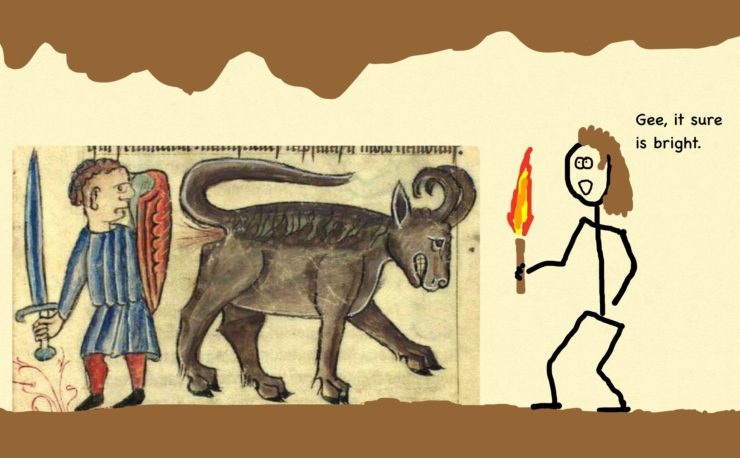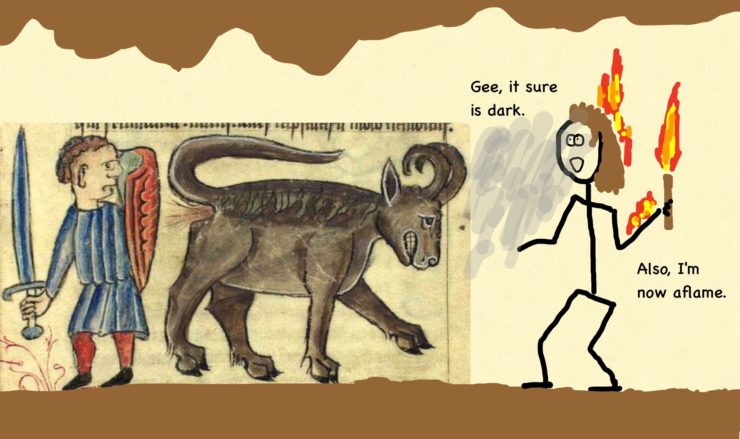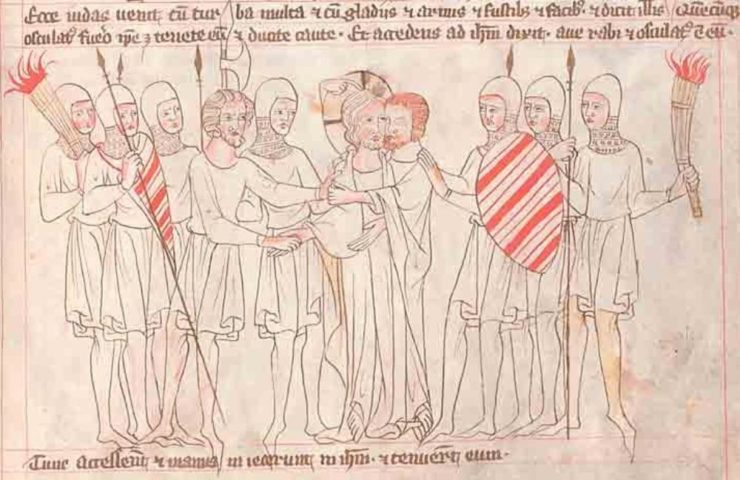How to hold a torch is almost certainly on the list of things I never thought I’d have to write about here. I mean, it’s pretty straight-forward, right?
I thought so, yet here I am.
I just returned from my first foray at DragonCon, you see. Due to other obligations, I was there for only a day, but I had a genuinely fine time with some genuinely fine people. I sat on a couple of panels, which are a great way to meet fellow authors and amazing fans. The whole thing was just grand and I hope I’m back next year (with more panels and more fans!).
Anyway, on one of these panels one of my fellow authors wanted to make a point about how mistaken most folks are about the reality of what I’ll term “adventuring”: there are a great many matters about which Hollywood and other popular culture have miseducated the public. He was observing, in other words, that there’s a gap betwixt real reality and perceived reality, and that those of us who know the real reality would do well to try to bring the perceived reality closer to it.
Thumbs up from me. I mean, I’m a professor of matters medieval whose career (and this column) is built on that gap … so, yeah, I totally agree. Educating is a good thing.
My fellow author then went on to stake a claim for his own expert status relative to the clearly uneducated and inexperienced masses. He made this point by standing up and announcing that people don’t even know how to hold a torch.
Further down the table, I perked up.
Said expert first held his hand (with its imaginary torch) out in front of his face. This is how everyone thinks you’re supposed to do it, he said. But holding it in front of your face blinds you!
In a dramatic sweep of his arms he then shifted his (still thankfully imaginary) torch into position behind his body. This is how you do it, he said. Only a fool would do it any other way!
Boom. Mic drop. Expertise established.
Only … well, um, that’s still not how you hold a torch.
I didn’t say anything at the time. It didn’t seem right to hijack the panel from the beginning with a discussion of proper torch-wielding techniques. And for all I know, said author was tired and just made a mistake. It happens.
But just in case …
Torch-holding 101
Since I can’t dramatically swing my arms around in front of you, let’s see how not to hold a torch by using the example of Medieval Bob, a terrible stick figure on a terrifying journey (which simultaneously serves as evidence of my complete non-expertise in artistic endeavors).
Out on an adventure, Medieval Bob has entered a cave. Unbeknownst to him, a bonnacon lurks within its lightless depths. Indeed, at the very moment in which we join our hapless hero, the bonnacon is deploying its acidic flatulence upon another traumatized warrior somewhere in the near darkness ahead.
Frightened, Medieval Bob lights his torch. First, he tries holding it in front of himself:

Nope. That isn’t going to work. He’s blinded by the light.
Well, it just so happens that Medieval Bob once heard an expert opine that torches ought to be held behind oneself. So he gives it a shot and finds that while he’s no longer blinded by the light (woo-hoo!) … he’s now casting his own shadow forward upon his path (doh!). He also realizes he faces other problems. In no particular order:
- He’s in a sub-optimal stance to move freely.
- In attack or defense, he’s disabled half of his abilities by taking his torch-hand out of use.
- He significantly increases the chance of setting himself on fire.

What will Medieval Bob do? Is all hope lost?
It is then, in this moment of potential despair, that a lightbulb quite anachronistically goes off over his head. Medieval Bob remembers that the sun doesn’t blind him when it’s high in the sky. Neither do the ceiling lights in Merlin’s house. If he could find a way to get the light of his torch over the line of his brow, why surely …

Huzzah! And behold! By the light of the Two Trees, there’s that dastardly bonnacon with its dung of doom! Medieval Bob needed only to lift his arm to see it clearly without blinding himself or hampering his ability to fight it.
Yes, folks, if it works for Lady Liberty and Muhammed Ali, it works for Bob and you and me.

As his arm tires, Medieval Bob will later discover that the torch held to his side will also work quite well. It is perhaps not quite as enlightening as an overhead hold — for the same reasons that ceiling lights tend to illumine a room better than floor lamps — but it’s a bit easier on the shoulder over the long-term.
Indeed, if you look across ancient and medieval statuary, reliefs, manuscripts, and other artifactual evidence — in other words, if you look at what the folks did who actually lived in a world of torches — you’ll see again and again that these two holds are standard. Here’s a 14th-century manuscript illumination of the Last Supper that actually depicts both:

Long story short: Torches aren’t held in front of your face or behind your back. They’re held high above the brow or off to the side of the body.
 Michael Livingston is a Professor of Medieval Literature at The Citadel who has written extensively both on medieval history and on modern medievalism. The Gates of Hell, the follow-up to The Shards of Heaven, his historical fantasy series set in Ancient Rome, comes out this fall from Tor Books.
Michael Livingston is a Professor of Medieval Literature at The Citadel who has written extensively both on medieval history and on modern medievalism. The Gates of Hell, the follow-up to The Shards of Heaven, his historical fantasy series set in Ancient Rome, comes out this fall from Tor Books.











You don’t want to be holding it vertical though, not with an old fashioned solid fuel torch. Harrison in the photo has it right, you want it tilted away so that any falling material hits the ground and not you. Old fashioned torches made of oil and, whatever material they had to soak the oil in, drop and sputter, and if you hold it vertical then you’ll get still burning stuff on your hand (if you are lucky, ’cause then you drop the torch and go to the hospital for a skin graft; unlucky and it hits your sleeve and sets you alight). You actually want it as close to horizontal and away from you as possible. An make wide gentle sweeps to shed light all around.
Source: The health and safety officer at the local re-enactment society, who had some truly gruesome slides to show us what happened if the oily material from the torch hit you.
Gas powered modern torches, like the Olympic one, can pretty much be held however you want.
I’d have to imagine that holding techniques would vary somewhat based on both the composition of the torch and the clothing and equipment one wears. Weather would also surely have been a factor. Then, of course, there’s the difference between a torch and a lantern, or for a more old-school alternative a lamp.
Semi-irrelevant matter – the medieval illustration is of the kiss of Judas and the arrest of Christ, which happened sometime after the Last Supper. (Because I am also a geeky medievalist.)
One of my pet peeves is the torches-stuck-in-wall-sconces that burn for hours. Sure, if they’re Victorian gas-powered. Not if they’re any time previous to that.
I’m trying (unsuccessfully) to picture how you’d hold a torch behind yourself. Most of us have these things called “shoulders” and “elbows” and tend to limit behind-the-back mobility — maybe if you had a tentacle?
#4 I assume it means you don’t walk face on, but torso twisted.
#3 I heard the theory that wall sconces for torches were basically just places to hang one so you’d have both hands free for whatever you needed to do that needed both hands free and you collected it again when you were done. For anything else there was candles or wick lamps, is that the case? That torches were basically flashlights (which is the name for flashlights in the UK) of the olden days?
The best example of mis-used sconces is video games with millennia-old dungeons being well lit by burning torches.
I love these kind of topics.
In a similar vein, the YouTube channel, Lindybeige, did a video on this topic that I particularly enjoyed about the night blindness torches can cause, too.
Link: https://youtu.be/3C96jTk2ss0
This is a wonderful article, and I love Medieval Bob… but why did you have to use Comic Sans? :)
Also, I know you probably see stuff like that all the time, but it’s so weird for me to see those Jesus-times guys wearing medieval armor.
I like stories that zing you with true facts like this – but only when incorporated into the story. Like, a know-nothing blinds himself and gets surprised, or lights himself up. Otherwise, boring detail that the person in the story already knows and wouldn’t be thinking about anyway.
Still waiting for the movie where a tense scene occurs as some villain chops the elevator cords so it’ll fall down the shaft and kill the hero inside, cue horrible music to make the audience panic, ha-ha! – then the elevator safety catch prevents the fall, nothing happens. Thank you, Mr. Otis.
Problem: Holding a torch up high means that you aren’t getting that cool lighting on your face, so the camera isn’t able to create the same mysterious and creepy feel. Also, you have less good trailergasm shots.
There is another Hollywood misstatement: That of grabbing a stick and tearing off a part of one’s shirt and wrapping it hastily; Then, taking the flask from the obligatory alcoholic member of the group and dousing the make-shift torch (and take a swig for yourself); Light the cloth and proceed to wave it about nervously to find the threatening entity.
While this might work as far as a quick source of illumination, the cloth would not hold to the stick for any length of time- especially not for a half hour or more as the movies would have you believe. In the “waving it about” motions, the fabric would loosen, and the ignited debris would sail through the air, catching either the user or their companions on fire and eliciting another trip to the burn ward for further skin grafting.
An informative article here. I do, however, have a question that may be unrelated: How were torches constructed to be left in a tunnel for extended periods and still be able to be lit? Or is that yet another misconception? I’m in process of writing a story inspired by the writings of REH and L. Sprague DeCamp and the Conan character. I would like this concern addressed so I don’t end up looking like some hack that doesn’t know what he’s talking about. Would I do better to have them use fat candles held within a lantern? Anybody?
When did people get around to inventing lanterns?
@17/swampyankee: The Romans already had lanterns. You can look at some examples here.
@18,
Thanks.
So, why aren’t these people carrying lanterns? Wouldn’t they be a trifle more convenient and less likely to set the tapestry on fire?
@19/swampyankee: Yes, probably.
I’m not an expert, but I have the impression that lanterns were more commonplace in ancient Rome than in the Middle Ages. Perhaps the people used torches because lanterns were too expensive, or not available.